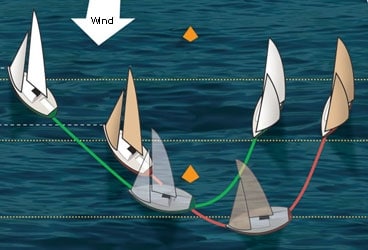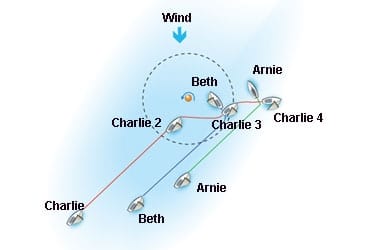
Crosses to Bear
Think that upwind cross is cut and dry? Think again. Dr. Dagley has eight ways to come out ahead in your next crossing. “Tactics” from our March 2008 issue

Think that upwind cross is cut and dry? Think again. Dr. Dagley has eight ways to come out ahead in your next crossing. “Tactics” from our March 2008 issue

To improve your on-the-water decision-making, think like a stock broker. “Tactics” from our July/August 2007 issue

When nighttime falls, have your house in order, a strategy for the weather, and a plan to push harder than your competitors. “Technique” from our July/August 2007 issue

Use these tips from North U’s Bill Gladstone to hit the line right on time, with speed.

Scrutinizing the “dial down” by Alinghi against Emirates Team New Zealand in the 32nd America’s Cup, Dick Rose identifies the critical match racing rule on which the Swiss syndicate capitalized. “Rules” from our January 2008 issue

When the boat starts rocking and rolling, rounding up or rounding down, there’s one simple technique to getting it back on its feet. “Technique” from our September 2007 issue

Andy Horton, who served as strategist/tactician for Luna Rossa in the 32nd America’s Cup, argues that “wide and tight” may not be so fast after all. “Technique” from our January 2008 issue

Top-ranked Laser sailor Andrew Campbell show us how to make the most out of the class’s new rigging rules. “Boatspeed” from our April 2007 issue

In this book published by the Royal Yachting Association, Mark Rushall explains complex tactical scenarios in simple terms. “Gear Up” from our December 19, 2007 /SW eNewsletter/

Three boats approach the windward mark on port layline. Which has the right to tack? Dick Rose considers this and other mark-rounding scenarios in “Rules” from our November 2007 issue.

Sharing knowledge passed down to him by the late Bruce Goldsmith, Bill Draheim explains the importance of the lifted tack.

Silence may be golden, but dialogue is fast; Andrew Kerr gets your team talking in this “Technique” piece from our October 2007 issue.

Think that upwind cross is cut and dry? Think again. Dr. Dagley has eight ways to come out ahead in your next crossing. “Tactics” from our March 2008 issue

To improve your on-the-water decision-making, think like a stock broker. “Tactics” from our July/August 2007 issue

When nighttime falls, have your house in order, a strategy for the weather, and a plan to push harder than your competitors. “Technique” from our July/August 2007 issue

Use these tips from North U’s Bill Gladstone to hit the line right on time, with speed.

Scrutinizing the “dial down” by Alinghi against Emirates Team New Zealand in the 32nd America’s Cup, Dick Rose identifies the critical match racing rule on which the Swiss syndicate capitalized. “Rules” from our January 2008 issue

When the boat starts rocking and rolling, rounding up or rounding down, there’s one simple technique to getting it back on its feet. “Technique” from our September 2007 issue

Andy Horton, who served as strategist/tactician for Luna Rossa in the 32nd America’s Cup, argues that “wide and tight” may not be so fast after all. “Technique” from our January 2008 issue

Top-ranked Laser sailor Andrew Campbell show us how to make the most out of the class’s new rigging rules. “Boatspeed” from our April 2007 issue

In this book published by the Royal Yachting Association, Mark Rushall explains complex tactical scenarios in simple terms. “Gear Up” from our December 19, 2007 /SW eNewsletter/

Three boats approach the windward mark on port layline. Which has the right to tack? Dick Rose considers this and other mark-rounding scenarios in “Rules” from our November 2007 issue.

Sharing knowledge passed down to him by the late Bruce Goldsmith, Bill Draheim explains the importance of the lifted tack.

Silence may be golden, but dialogue is fast; Andrew Kerr gets your team talking in this “Technique” piece from our October 2007 issue.
Sign up for Sailing World emails to receive features on travel destinations, event listings and product reviews as well as special offers on behalf of Sailing World’s partners.
By signing up you agree to receive communications from Sailing World and select partners in accordance with our Privacy Policy. You may opt out of email messages/withdraw consent at any time.